
Wind turbines under construction


A very large breakfast burrito, covered in a warmly spiced green chili at Taos Diner II
We were hoping to wander around the town, but there was zero free parking. Besides, everything looked so terminally chic. So we moved along up to the old pueblo. Even this had succumbed to the effect of tourists. Not only was it very expensive to enter, you also had to pay a supplemental fee to take photos (and that was just for private use only. You had to apply for some permit if you wanted to use anything commercially). Plus tax. So we were determined to get our money's worth and spent almost the entire time behind the lens.

The Taos Pueblo is called Teotho in the Tewa language, meaning Place of the Red Willows. It has always been a crossroads for trade and is considered to be the oldest continuously inhabited community in the US. Tewa is an oral language only, never having been written by its speakers. The claim is that the pueblo looks just as it did in 1540 when the Spaniards saw it. I wonder if it was just as expensive back then?


The Tribal Council is comprised of over 30 former tribal leaders. They select the officials for the governor's and Warchief's offices every year. The governor is responsible for the civil and business issues within the village, as well as relations with the outside world. The Warchief is responsible for the protection of tribal lands outside the village walls (the wildlife and natural resources).
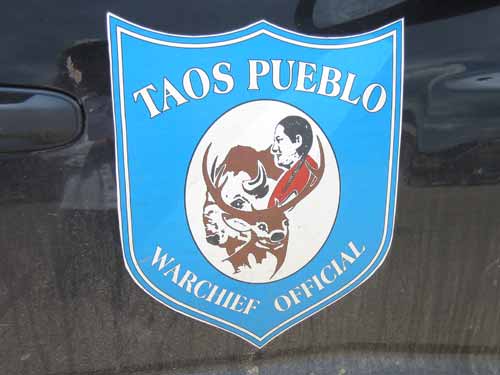

The layout of the village. At one time, the entire village used to be surrounded by an adobe wall 10 feet tall.
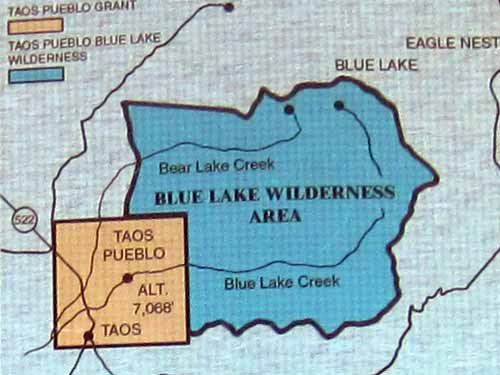
The Blue Lake Wilderness Area is over 100,000 acres of land with exclusive use to the tribe for traditional purposes, including hunting. In 1906, this area was established as a national forest, but in 1970, it was returned to the reservation. It is very rare that land is ever returned.
There was a free tour starting at 1 pm at the church so we wandered over and waited... and waited... and waited. The man was over 15 minutes late. We followed him around the north half the pueblo, learning about the culture and old ways of life. While it was apparently customary to tip at the end, we felt we had already spent quite enough. We then took our time wandering around on our own, exploring the areas on both sides of the small stream that ran through it. Art stores (with insane prices) filled many of the adobe buildings.

The San Geronimo Church was built in 1850. It is one of the youngest buildings in the village. It is a mixture of both Catholic practices and native rituals (such as the kivas). Saint Jerome was born in modern-day Croatia in the year 342.

A statue of the Virgin Mary (inside, but we couldn't take pictures) symbolizes Mother Earth and is associated with the crops. She is adorned in different colors throughout the year. She was currently wearing blue (for the monsoon season), but she also wears green (spring), white (winter), pink (darn, I can't remember), etc.


The buildings are made from adobe, which is earth, straw and water mixed and poured into forms which are left to sun dry.
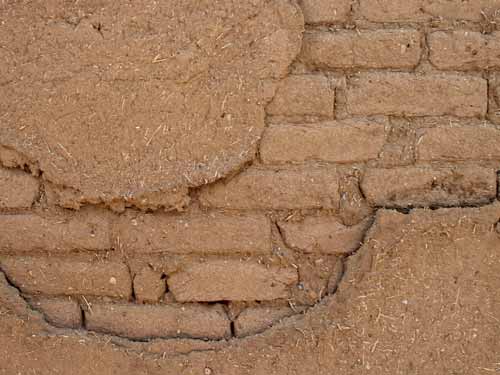
The resulting bricks are then stacked and bonded together with the same adobe mixture. The walls are frequently several feet thick and coated with a white wash (made from white soil) inside to keep the rooms bright and clean. The exteriors need to be plastered annually due to the harsh seasons. The bricks are insulating... keeping the buildings 15 degrees F cooler in summer and warmer in winter. Making a building was a community effort.

The roofs are supported by large timbers (vigas) with smaller boards (latillas) on top. It is then compacted with earth. They couldn't support a lot of weight or moisture, so snow had to be removed as soon as possible.


Originally the houses had no doorway and no windows. People entered through a hole in the roof. This used to be a very hostile with regular raids from Apache, Ute, and Comanche. The puebloans used pull up the ladders so they would be safe inside. Two to eight people lived per house. There was no furniture, just some bedding of bear or buffalo hides. Nowadays only propane is allowed. There are no other utilities (no water, gas, or electric). They use the river water to cook, bathe, drink and irrigate crops. Some of the houses now have wood fireplaces… and apparently modern staircases as well.

A traditional ladder. Note the one side is much longer than the other. This made it much easier to step on and off the ladder. I wish I had one for my roof!


Secretly hidden away in the back!

The large open area is the Northern Plaza. It was used for dances and trading.

The North House (Hlaauma) is five-stories tall. Everyone had to enter from the roof and sometimes the way down to the lower rooms wasn't very direct. There are no connecting internal doorways. The outer doorways are a more recent addition.

An idea of what it might have looked like inside.

People (known as the Red Willow People) still live here. The pueblo used to have 2,000 - 3,000 residents but currently houses only 100 - 200 today.
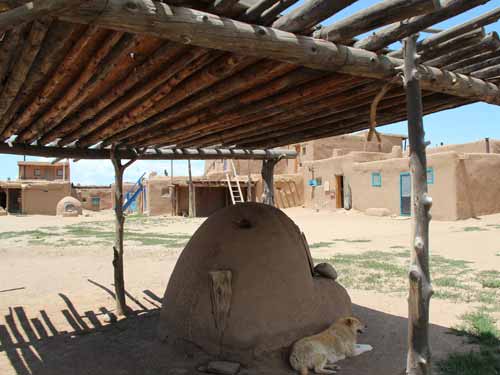
The wooden racks were used for drying corn, squash, beans, meat, skins, etc. The outdoor baking oven (called horno) was introduced by the Spanish and is used for various things such as bread, pottery, cookies, pies, etc.

Trying to escape the heat of the day
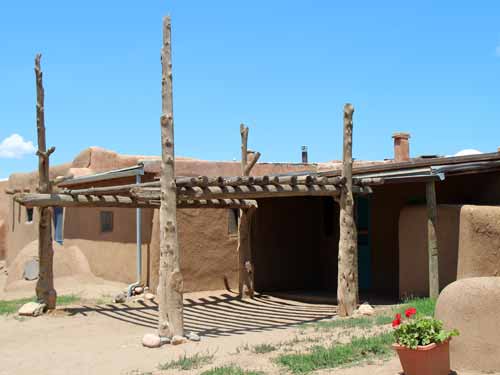
Another drying rack

More ovens
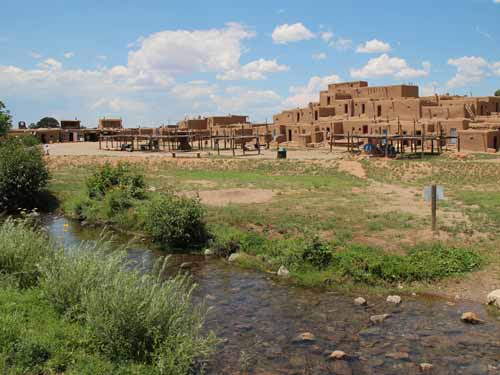
The Red Willow Creek is so named after the plants that grow along its banks. It flows from Blue Lake, 8 - 10 miles away, high in the Sangre de Cristo Mountains.

The South House (Hlaukkwima) is four-stories tall. Both houses were also used as lookouts.


Traditional images of the Southwest. We went into one the numerous galleries on the south side. It was surprisingly VERY large, with five rooms. It was indeed a good 15 degrees cooler! They did have some lovely stuff... but it was quite out of our price range.

I agree!


Traditional style corn... not our simple yellow stuff

Ristra - a string of fresh or dried red chili (or chile... as it is spelled down here in the southwest) peppers which are a major ingredient in the traditional cuisine.

The doors were all brightly painted.... mostly blues, but also reds and greens.

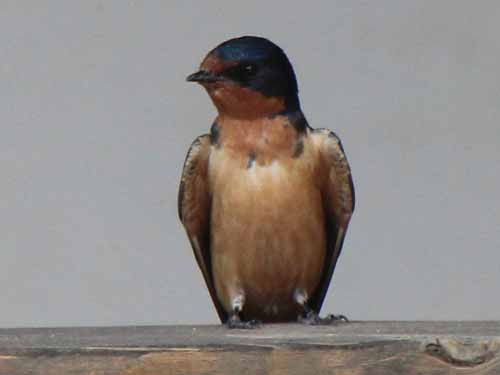
A Barn Swallow rests for a moment.

A Rufous Hummingbird
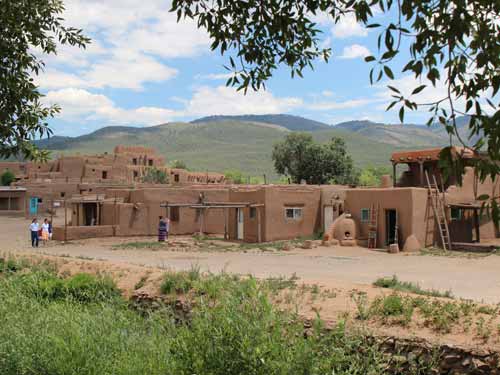
Back on the other side of the river, looking to the south side

Overlooking the north side

Two traditional, sacred kivas
The cemetery is where the original church once stood. In was built around 1619 by Spanish priests using local labor. The people were forced into Catholicism and slavery in order to become "civilized." Eventually they revolted in 1680. They were successful and lived freely until reconquered in the 1700's. The church was rebuilt.
Fast forward to the Mexican-American war. In 1847, the puebloans decided to help overthrow the US government and killed the local governor, Charles Bent. In retaliation, the US hung several of the leaders in the town plaza. Most people ran to the hills but about 150 ran to the church. The US destroyed the church, killing everyone inside, unaware that they weren't enemy soldiers.

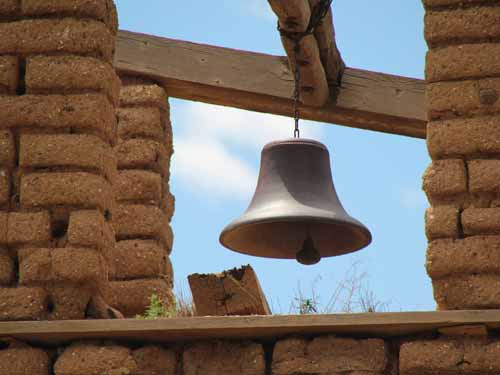
The church bell is still the original one brought by the Spanish. The top of the tower was repaired in the 1970's so that the bell could be hung up again. Before that, it was just lying in the rubble.

The crosses contain lots of Spanish names. In order to do a census, Spanish names were given to the people, but they also still use their native names.

In spite of looking very old, most of these were relatively new.




There were many images of this upwards pointed bird.

Back on the northern side, we popped in one more store. We had a lovely time talking with the woman (who was actually decorating her pots) all about her family, life in the village, and the value of the culture. There was also zero pressure for us to buy anything.
We began our drive to Santa Fe at around 3 pm. Traffic was starting but we made it to our hotel room before things got too bad.

